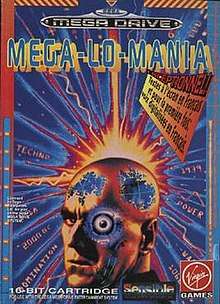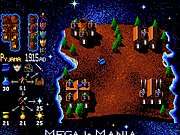Mega-Lo-Mania
| Mega-Lo-Mania | |
|---|---|
 European Sega Mega Drive cover art | |
| Developer(s) | Sensible Software |
| Publisher(s) | Virgin Interactive |
| Designer(s) |
Jon Hare Chris Yates |
| Composer(s) |
Richard Joseph Michael Burdett Matt Furniss (Mega Drive) |
| Platform(s) | Amiga, Atari ST, Mega Drive/Genesis, Super NES, DOS, Sharp X68000, PC-98 |
| Release | |
| Genre(s) | Real-time strategy |
| Mode(s) | Single-player |
Mega-Lo-Mania is a real-time strategy computer game developed by Sensible Software. It was released for the Amiga in 1991, and ported for a variety of other platforms. It was released as Tyrants: Fight Through Time in North America and Mega-Lo-Mania: Jikū Daisenryaku (メガロマニア時空大戦略) in Japan.
Gameplay
Mega-Lo-Mania is an early real-time strategy game that predates Dune II by a year. The player takes control of one of four gods; Scarlet (red), Caesar (green), Oberon (yellow) and Madcap (blue). There are no differences between them except colour and AI behaviour when opposing. Each level takes place on an island divided into two to sixteen "sectors". The objective is to defeat up to three opposing gods and conquer the island.

There are twenty-eight islands in the game, which are named in alphabetical order (except the last two) and grouped into ten epochs. Each epoch contains three islands and represents a different era in time (starting at 9500 BC and ending at 2001 AD); conquering the three islands in any order will allow the player to proceed to the next epoch. The player receives one-hundred men in each epoch. Any unused are carried over to the next epoch. The only exception is the tenth epoch, which contains only one island and does not grant extra men to the player.
Before a level begins, the player decides which sector to place their first tower in, and how many men to deploy. The men can perform various tasks such as designing weapons and shields, mining elements, building structures, manufacturing weapons and forming an army. The number of men assigned to a single task determines how fast or effective it will be. Men that are left idle will procreate and gradually increase in number.
At the start of a level the player only has unarmed men available. To gain more powerful weaponry, the player must assign men to design technology. When enough designs are made, the sector will advance a tech-level; making more research and buildings available. Armies can be used to either invade enemy sectors, or build a tower in an empty sector; expanding the player's territory. Shields are used to repair damaged buildings. Weapons and shields can only be made if enough elements have been gathered. Higher-tech weapons and shields must be manufactured in the factory before use. Building a mine gives access to more elements and the laboratory improves design tasks.
If the sector's tower gets destroyed, the player loses control of that sector. If the player has no sectors or men left, the level must be restarted.
The player has the option to form an alliance with an opponent if there are two or three present on the map. An allied opponent will not attack the player but neither of them can expand their territory whilst allied. Alliances cannot be made if only one opponent is remaining on the map.
Reception
| Reception | ||||||||||||||||||||||||||||
|---|---|---|---|---|---|---|---|---|---|---|---|---|---|---|---|---|---|---|---|---|---|---|---|---|---|---|---|---|
| ||||||||||||||||||||||||||||
| ||||||||||||||||||||||||||||
Mega-Lo-Mania is considered to be the first Real time strategy game to also incorporate a technology tree and was met with universal acclaim on its original release. Amiga Power was impressed by the game, describing it as "another game to add to that list of all-time greats."[13] Mega placed the game at #34 in their Top Mega Drive Games of All Time.[14]
Conversions to other platforms sometimes got less praise. Computer Gaming World cited many bugs and flaws, and stated that even if they were fixed "not enough attention has been paid to gameplay".[15] A 1994 survey of strategic space games set in the year 2000 and later gave the game two-plus stars out of five, stating that the Populous "clone ... offers a short diversion into strategic whimsy before degenerating into an also-ran".[12] MegaTech magazine said that it was "very easy to get into (but) there are only nine levels".
References
- ↑ MegaTech rating, EMAP, issue 22, page 100, October 1993
- ↑ Mega review, issue 6, page 39, March 1993
- ↑ ACE Magazine, issue 49, Oct 1991
- ↑ Amiga Action Magazine, issue 25, Oct 1991
- ↑ Amiga Computing, issue 41, Oct 1991
- ↑ Amiga Force, issue 10, Oct 1991
- ↑ Amiga Format, issue 26, Sep 1991
- ↑ Amiga Power, issue 5, Sep 1991
- ↑ CU Amiga, Sep 1991
- ↑ The One, issue 36, Sep 1991
- ↑ Zero, issue 24, Oct 1991
- 1 2 Brooks, M. Evan (May 1994). "Never Trust A Gazfluvian Flingschnogger!". Computer Gaming World. pp. 42–58.
- ↑ http://www.outofprintarchive.com/articles/reviews/Amiga/MegaLoMania-AmigaPower5-4.html
- ↑ Mega magazine issue 26, page 74, Maverick Magazines, November 1994
- ↑ Brassil, John (June 1993). "UbiSoft's Mega lo Mania". Computer Gaming World. p. 148. Retrieved 7 July 2014.